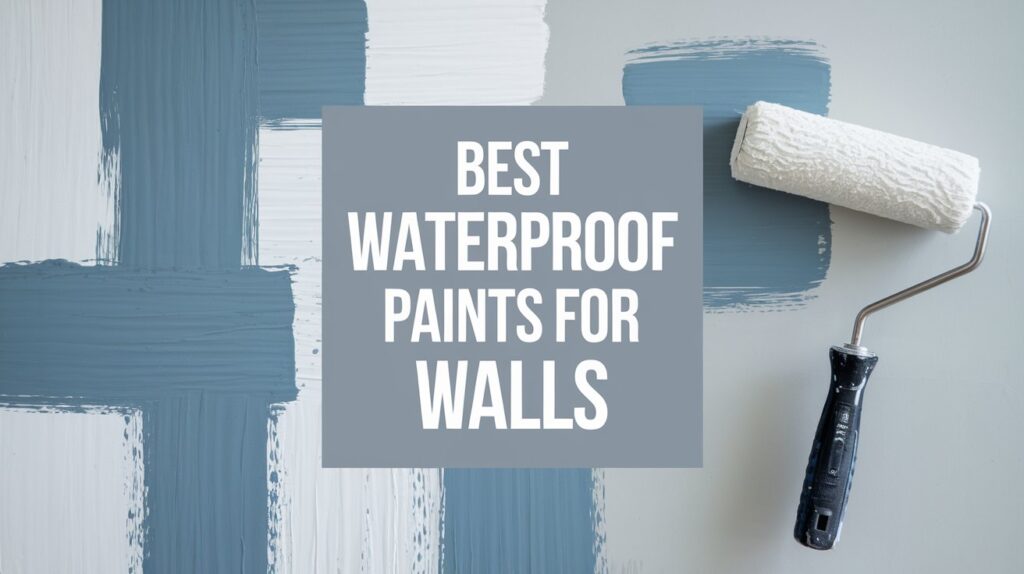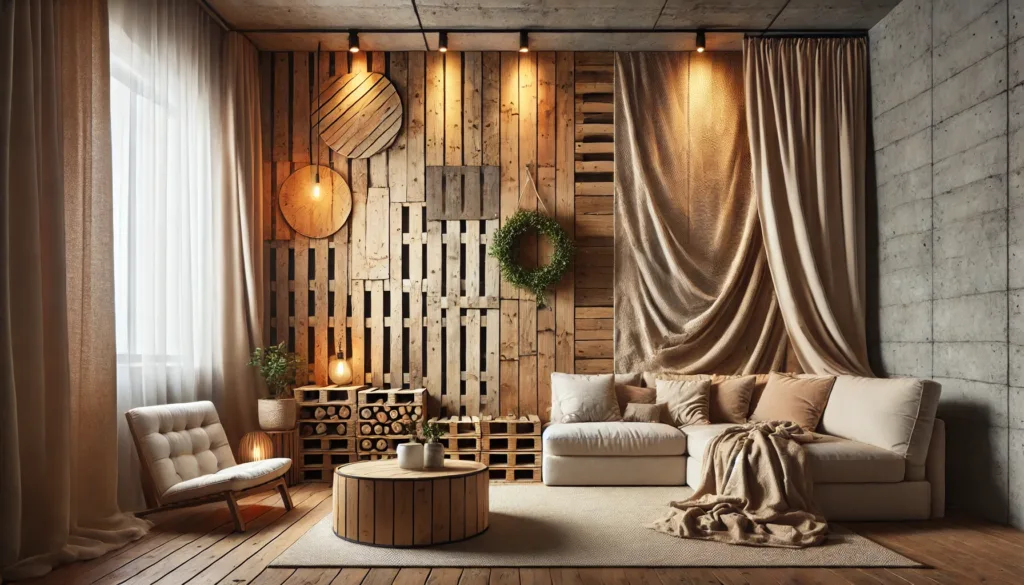Homeowners often feel the need to fix everything before selling. But, this can take a lot of time and money. It’s smarter to focus on the repairs that really matter. These are the ones that boost your home’s value and appeal to buyers.
In this article, we’ll look at what not to fix when selling a house. By knowing what repairs to prioritize, you can save time and money. This way, you’ll attract the right buyers.
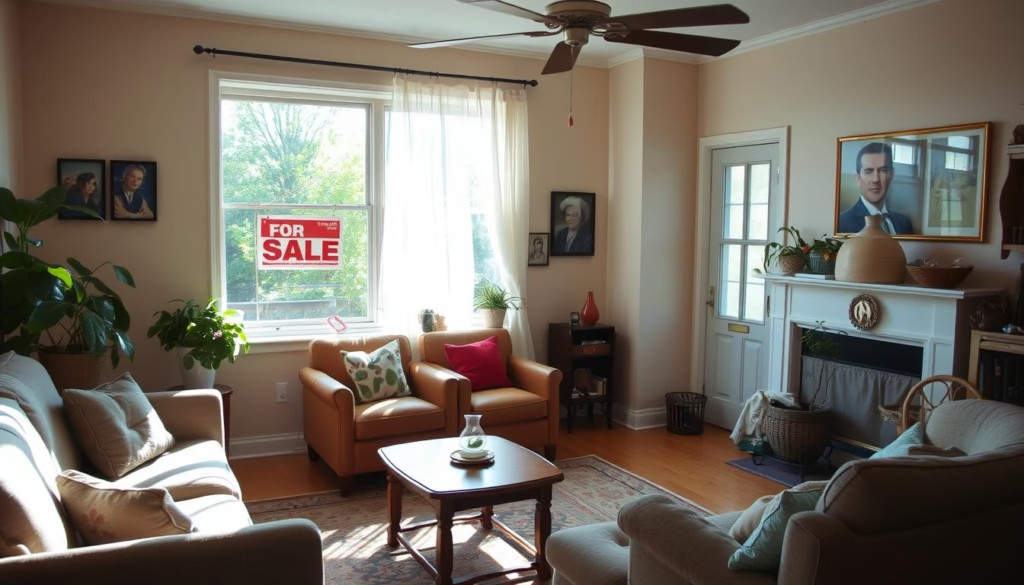
Key Takeaways
- Identify the essential repairs and upgrades that will provide the highest return on investment for your home sale.
- Understand the current market conditions and buyer preferences to make informed decisions about what to fix and what to leave as-is.
- Focus on improving the home’s overall curb appeal and functionality, rather than getting caught up in minor cosmetic issues.
- Prioritize repairs that address safety, functionality, and energy efficiency over purely aesthetic improvements.
- Avoid unnecessary renovations or upgrades that may not be recouped in the sale price.
Understanding the Home Selling Process and Repair Priorities
Selling a house involves knowing the home selling process and what repairs to do first. By studying the market and checking your home’s condition, you can choose the right improvements. This helps you list your home wisely.
Market Analysis and Property Assessment
Start by looking into your local real estate market. Check out recent sales of similar homes. Note the average price, how long they were on the market, and how much demand there was. This property assessment helps you set a good price and highlights your home’s special features.
Distinguishing Between Essential and Optional Repairs
Then, take a close look at your home to find essential repairs. These are fixes that affect the home’s function, safety, or look. They’re key for buyers. Optional repairs, on the other hand, can make your home look better but might not add much value.
Cost vs. Return on Investment Considerations
When picking repairs, think about the cost vs. ROI of each one. Focus on essential repairs that boost your home’s value and appeal. Don’t spend too much on improvements that won’t give you a good return.
By understanding the market, assessing your home, and choosing repairs wisely, you can get your home ready for a successful sale.
Minor Cosmetic Issues That Won’t Impact Your Sale
When getting your home ready to sell, it’s easy to want to fix everything. But, some small cosmetic repairs can be ignored without hurting your home’s appeal. In fact, spending too much time on tiny flaws can take away from more critical home staging and curb appeal tasks.
If you’re selling your home, here are some quick fixes that won’t affect your sale price or interest:
- Scuff marks on walls or trim can be easily touched up with paint, no need for a full repaint.
- Outdated light fixtures or hardware can remain as-is, as buyers often prefer to customize these elements to their own taste.
- Minor cracks or chips in tile or countertops may not warrant a full replacement, especially if the overall surfaces are in decent condition.
- Worn carpeting can be left alone if the floors are otherwise clean and presentable, as many buyers opt to replace flooring after moving in.
The main goal is to spend your time and money on making your home look great. This means focusing on cleaning, decluttering, and showing off your home’s best features. By ignoring minor cosmetic repairs, you can use more resources to boost your home’s curb appeal and appeal to buyers.
“Don’t sweat the small stuff when it comes to selling your home. Concentrate on the big picture and let the minor cosmetic issues slide.”
Outdated but Functional Kitchen Features
When selling a house, finding the right balance is key. You want to update what’s needed but keep what works. The kitchen is especially important here. It can make or break a sale. Let’s look at what you can keep and what might need a little touch-up.
Older Appliances That Still Work
New appliances can impress, but old ones that work are okay too. If they’re clean and do the job, it’s smart to save money. Buyers might like the chance to pick out their own appliances later.
Cabinet and Countertop Considerations
For cabinets and countertops, a fresh paint or refinish can make a big difference. Check if they’re still good to go. If they are, a quick update can make them look new again. This saves money and effort.
Floor Tiles and Backsplash Decisions
Dated tiles and backsplashes might not need a full redo if they’re clean. A deep clean or new grout can make them shine. If they’re really bad, a simple update in a classic style can help a lot.
It’s all about making smart choices in the kitchen. Focus on updates that save money and still look good. This way, your kitchen will attract buyers without costing too much.
When to Skip Bathroom Renovations
The bathroom can be a challenge when selling a house. Some bathroom remodel projects can boost a home’s value. But, not all updates are needed. Skipping certain renovations can help sell a house fast and efficiently.
If the fixtures like toilets, sinks, and showerheads work well and look good, it’s best to keep them. Buyers might see the savings and choose to do their own tile work or vanity upgrades later.
- Existing fixtures in good working condition
- Minor tile work or vanity upgrades can be left for the buyer
- Avoid costly and time-consuming bathroom bathroom remodel projects
Also, if the tile work and vanity are old but still work, it’s okay to leave them. Replacing them can cost a lot. Buyers might be okay with doing it themselves if the bathroom is clean and works well.
| Scenario | Recommendation |
|---|---|
| Existing fixtures in good condition | Leave as is |
| Dated but functional tile work and vanity | Consider leaving as is |
| Severely outdated or damaged bathroom components | Undertake necessary bathroom remodel updates |
Choosing to renovate or not should depend on the bathroom’s state and the return on investment. Focusing on the basics and avoiding big bathroom remodel projects can save time and money. This way, homeowners can attract buyers without spending too much.
Selling a House With Original Windows
When selling a house, the state of the windows matters a lot. Some might think about replacing them, but keeping original windows is key for historic homes. They add character and charm.
Energy Efficiency Factors
Today, energy efficiency is crucial for homebuyers. But, older windows can be as efficient as new ones if well-maintained. Adding double-glazing or storm windows can improve their energy performance.
Window Repair vs. Replacement
Fixing windows is often cheaper than replacing them. Professional restoration can fix issues like drafts and cracks. This keeps the home’s original charm, attracting buyers who value history.
Buyer Expectations for Windows
Smart buyers see the value in original windows in historic homes. They appreciate the craftsmanship and are willing to maintain and upgrade them. Showcasing the condition and energy-saving potential of original windows can highlight their value.
| Window Condition | Energy Efficiency | Buyer Perception |
|---|---|---|
| Well-maintained original windows | Upgrades can boost efficiency | Appealing historic charm |
| Poorly maintained original windows | May require more energy upgrades | Potential drawback for buyers |
| Replaced modern windows | Typically more energy-efficient | May lack historic character |
Non-Essential Exterior Improvements to Avoid
When selling your home, focus on key curb appeal factors. Extensive landscaping or siding replacement might seem good, but they’re often better for the next owners.
A fresh exterior paint job can boost your home’s look. But, you don’t need to paint the whole house. Just do touch-ups and fix spots to save money and keep your home looking good.
- Pay attention to areas like the front door, trim, and weathered spots.
- Try a power wash to clean the siding and make it look new.
- Don’t replace siding unless it’s really bad or hurts your home’s look.
Landscaping is important for a welcoming look, but big garden projects or tree work might not be worth it. Instead, aim for a neat, tidy look that shows off your property’s best.
- Keep up with lawn care like mowing, edging, and removing debris.
- Trim shrubs and trees to keep things neat and organized.
- Add a few potted plants or a simple flower bed near the entrance.
Focus on the most important curb appeal updates and skip the non-essential projects. This way, you can improve your home’s selling chances without spending too much on things that might not pay off.
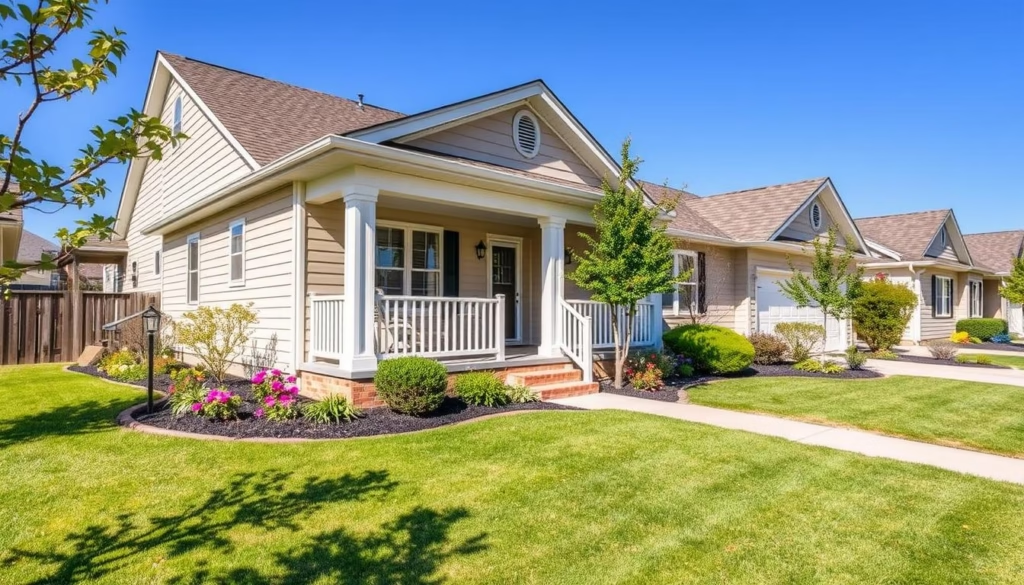
“Enhancing your home’s curb appeal doesn’t have to mean a complete overhaul. Sometimes, the little things can make a big difference.”
Flooring Updates You Can Skip
When selling a house, focus on updates that offer the best return on investment. Flooring might seem like a key area, but sometimes, you can skip expensive replacements. This way, you can still attract potential buyers without breaking the bank.
Carpet Replacement Guidelines
If your carpet is in good shape, with no big stains or wear, think about a professional carpet cleaning instead of replacing it. This can make your floors look new again. It saves money and keeps your home looking great.
Hardwood Floor Considerations
Hardwood floors are very popular, but if yours are okay, hardwood refinishing might be cheaper than replacing them. This method can make your floors shine again. It’s a smart way to save money without losing the charm of hardwood.
Tile Work Decisions
- If only a few tiles are damaged or look off, replace just those. Don’t redo the whole floor or backsplash.
- For old tile patterns or colors, a deep clean and re-grouting can update the look. You won’t need to replace everything.
Choosing smart flooring options can help you save money. This way, you can make your home more appealing without spending too much. This strategy can help you get a better return on investment when selling your house.
When to Leave the HVAC System As-Is
When selling your home, the HVAC system is a big deal for buyers. Sometimes, it’s smart to keep the current HVAC system. This avoids the high cost of replacing it.
Look at the current condition and maintenance of your HVAC. If it’s well-kept and works well, it might not need to be replaced. HVAC maintenance can make it last longer, which is good for the new owners.
Also, think about the energy efficiency of your HVAC. Newer systems might save more energy, but replacing yours might not be worth it. Energy efficiency is key, but so is the system’s overall condition and how well it works.
The home inspection will check your HVAC closely. If it’s in good shape and meets safety and performance standards, you might not need to replace it. The new owners can then choose to keep it or upgrade later, depending on their needs.
In short, when selling your home, think hard about your HVAC system’s condition, maintenance, and energy efficiency. Often, keeping the current system is a smart move. It’s cost-effective and meets the needs of the new homeowners, as long as it works well and efficiently.
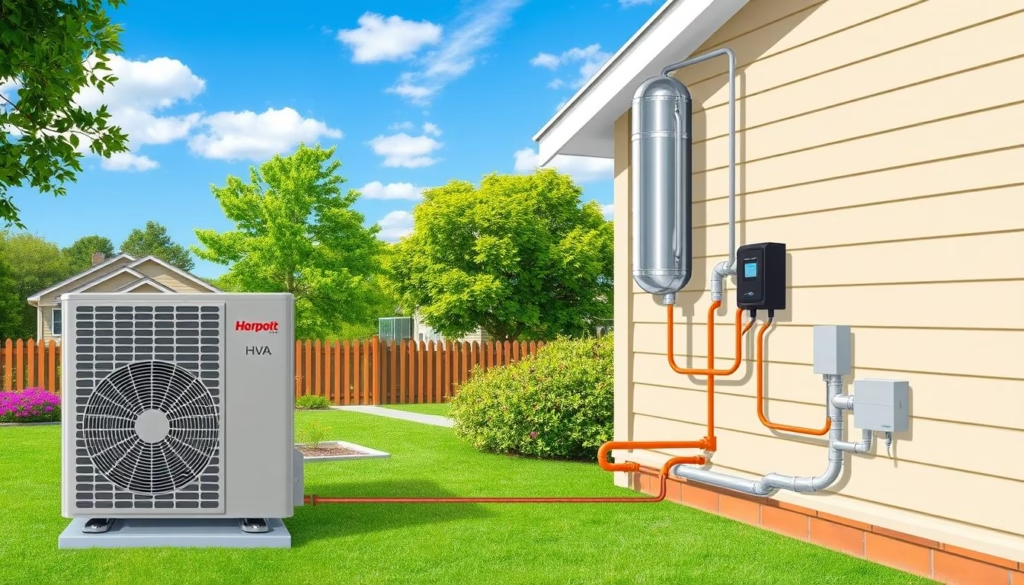
Paint Colors and Wall Treatments to Ignore
When selling a house, it’s easy to want to update everything. But, when it comes to paint colors and wall treatments, sometimes it’s better to leave them alone. Certain neutral colors and accent walls can actually make your home more appealing.
One big mistake is removing wallpaper before selling. While old wallpaper can be a turnoff, removing it is messy and time-consuming. Unless the wallpaper is really bad, it’s best to let the new owners decide if they want to change it.
Neutral paint colors like beige, gray, and white are great because they let buyers imagine their own style. Don’t feel pressured to repaint everything in the latest trends. Those accent walls you love might not be everyone’s cup of tea.
The main goal is to focus on the most important repairs and updates. Don’t get too caught up in cosmetic changes that might not really add value. By knowing which paint colors and wall treatments to ignore, you can save time, money, and stress when selling your home.
Conclusion
When selling your home, focus on updates that really matter. It’s key to find the right balance. You want to fix big problems but avoid spending too much on small things.
Know the market trends and check your home’s condition. This helps you decide which improvements are worth it. You might need to do some cosmetic work or replace big systems. The goal is to increase your home’s property value and attract buyers without breaking the bank.
Choosing the right real estate strategy is crucial. It affects how you sell your home and the price you get. Focus on the most important updates. This way, you’ll sell your home successfully and meet your financial goals.
I hope this article on ‘What Not to Fix When Selling a House’ provides you with valuable insights and benefits your home-selling journey. If you found this helpful, don’t forget to share it with your friends and family who might also be looking for this kind of knowledge!
FAQ
What are some minor cosmetic issues that won’t impact a home sale?
Small issues like scuffed walls or outdated light fixtures are often ignored by buyers. They don’t really hurt a home’s appeal. It’s better to focus on big repairs and improvements than every little cosmetic flaw.
When can I skip extensive bathroom renovations?
If your bathroom is still working, even if it’s old, you might not need a full makeover. Buyers usually care more about the kitchen and living areas. So, bathroom updates can wait for the new owners.
How can I sell a home with original windows?
Old windows are okay in historic homes. Just make sure they’re in good shape and energy-efficient. Emphasize the original windows as a plus, not a minus.
What exterior improvements can I avoid when selling?
You don’t have to do a lot of outside work. Just keep the lawn nice, trim the hedges, and paint the front door. These simple steps can make a big difference.
When can I leave the HVAC system as-is?
If your heating and cooling works well, you might not need to replace it. Show proof of recent maintenance and talk about its energy savings. This can reassure buyers.
What paint colors and wall treatments can I keep as-is?
Neutral colors are usually safe, but unique touches like accent walls can be okay. They might even be a selling point in certain homes or areas.
